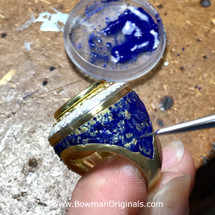Posted by Bowman Originals on Jul 26th 2025
The Art of Enamel: Vitreous Enamel vs Resin Epoxy

The Art of Enamel: Traditional Vitreous Enamel vs. Modern Resin in Fine Jewelry
In the world of fine jewelry, the choice of materials is more than just aesthetics—it’s a matter of tradition, craftsmanship, and lasting value. Among the many elements that define a piece of jewelry, enamel plays a pivotal role in adding color, depth, and artistic expression. Today, we explore the essential differences between traditional vitreous enamel and modern resin enamel, and why the time-honored technique of vitreous enamel remains the gold standard for collectors, artisans, and connoisseurs alike.
The Legacy of Vitreous Enamel
Vitreous enamel, also known as "hot enamel" or "true enamel," has been used for over 2,000 years. Originating in ancient Egypt and perfected during the Byzantine and Renaissance periods, it involves fusing powdered glass to metal at temperatures exceeding 1,400°F (760°C). This high-heat process transforms the glass powder into a lustrous, durable surface that becomes one with the underlying metal.
The technique is painstaking and unforgiving. Each layer must be fired with exact timing and precision, and even a minor misstep can cause cracks or bubbling. Mastering vitreous enamel takes years of experience—often a lifetime. Yet, the result is breathtaking: a piece of jewelry that shimmers with a translucent glow, resists fading, and becomes more beautiful with age. View our Vtreous Enamel Jewelry
What Is Resin Enamel?
Resin enamel is a modern, synthetic alternative made from pigmented epoxy resins. Unlike vitreous enamel, resin is applied cold and allowed to air-dry or cure with UV light. It’s a simpler, faster process that appeals to mass production and high-volume manufacturing. Resin can mimic the look of enamel to a degree, but it lacks the rich depth, permanence, and authenticity of true vitreous enamel.
The Key Differences
|
Feature |
Vitreous Enamel |
Resin Enamel |
|
Material |
Ground glass |
Epoxy resin |
|
Application |
Fused with heat (1400°F+) |
Cured with air or UV light |
|
Durability |
Extremely durable, glass-hard, won’t discolor |
Softer, can fade, scratch, or yellow over time |
|
Craftsmanship |
Requires skill, fire, and artistic discipline |
Easier and quicker, suited for mass production |
|
Heritage |
Ancient and respected tradition |
Contemporary and cost-effective substitute |
Why We Choose Vitreous Enamel
At Bowman Originals, we favor tradition. Every enameled piece is created using the centuries-old vitreous technique, hand-applied and kiln-fired in our Sarasota, Florida studio. We don’t compromise on quality or authenticity.
Why? Because our clients deserve jewelry that endures. Jewelry that doesn’t dull with time. Jewelry that speaks of artistry—not imitation.
Each stroke of enamel tells a story of fire, patience, and passion. No two pieces are exactly alike, and that's the beauty. The rich color, the slight variations, the way light dances across its surface—these qualities make vitreous enamel a living part of every heirloom.
A Testament to Timelessness
While resin enamel may suffice for costume jewelry and fast fashion, it will never match the prestige or permanence of vitreous enamel. For those who value excellence, tradition, and beauty that lasts generations, the choice is clear.
Vitreous enamel isn’t just a technique—it’s an art form.
Learn more about Bowman Originals Jewelry
